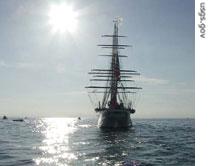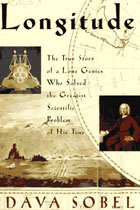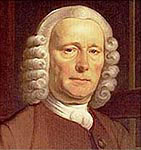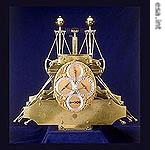VOA慢速英语 2008 0402b
时间:2019-01-11 作者:英语课 分类:VOA慢速英语2008年(四)月
This is Steve Ember.
VOICE TWO:
And this is Bob Doughty 1 with the VOA Special English program EXPLORATIONS. Today, we tell about how people learned an important piece of information necessary for safely sailing on the oceans. It is called longitude 2.
(MUSIC)
VOICE ONE:

Far away from land, ships need to find their longitude so they can know where they are
On a foggy October night in seventeen-oh-seven, four English navy ships hit rocks in the Atlantic Ocean and sank. Two thousand men drowned. The ships had been sailing in the thick fog for twelve days. There was no sure way to know where they were. The commander of the ships had been worried that they could hit rocks if they were not careful. He asked his navigators for their opinion on their location in the ocean.
The navigators did not really know. They told the commander they thought they were west of a small island near the coast of northwestern France.
They were wrong. Instead, they sailed onto rocks near a small group of islands southwest of England's Atlantic coast. The navigators' lack of knowledge led to the loss of four ships and two thousand lives.
VOICE TWO:
When people began sailing out of sight of land, sailors did not know how to tell where they were on the open sea. Land travelers can look at a mountain, or a river, or an object that shows them where they are in relation to where they came from. On the ocean, however, there is no sign to tell a sailor where he is.
The most important device for knowing directions on the ocean is a compass. A compass is a device containing a metal object that points toward the magnetic north pole. This shows navigators the direction of north, and therefore also south, east, and west. But sailors need more information to sail safely on the open sea.
VOICE ONE:
Most maps of the world show lines that are not on the Earth's surface. One line is the equator 3. It is an imaginary line around the widest part of the Earth. There are similar lines both north and south of the equator. These circles become smaller and smaller toward the north pole and the south pole.
These lines, or circles, are parallel - meaning that they are equally distant from each other at any point around the world. These lines show what is called latitude 4.
A navigator can know the latitude of his ship by observing the location of stars, where the sun rises in the morning and sets in the evening, and what time of year it is. With this information he knows where his ship is in relation to the north or south pole and the equator.
VOICE TWO:

''Longitude'' by Dava Sobel
Still, there is one more important piece of information necessary for safely sailing the oceans. For many centuries, scientists, astronomers 6 and inventors searched for a way to tell longitude. The lines of longitude go the other way from latitude lines. They stretch from the north pole to the south pole, and back again in great circles of the same size. All of the lines of longitude meet at the top and bottom of the world.
In her book, “Longitude,” writer Dava Sobel tells the story about longitude and how the problem of knowing it was solved.
(MUSIC)
VOICE ONE:
For centuries, the great scientists of the world struggled to develop a way to learn longitude. To learn longitude at any place requires knowledge about time. A navigator needs to know what time it is on his ship and also the time at another place of known longitude - at the very same moment.
The Earth takes twenty-four hours to complete one full turn or revolution of three-hundred-sixty degrees. One hour marks one twenty-fourth of a turn, or fifteen degrees. So each hour's time difference between the ship and the starting point marks a ship's progress of fifteen degrees of longitude to the east or west. Those fifteen degrees of longitude mark a distance traveled.
At the equator, where the Earth is widest, fifteen degrees stretches about one thousand six hundred kilometers. North or south of that line, however, the distance value of each degree decreases. One degree of longitude equals four minutes of time all around the world. But in measuring distance, one degree shrinks from about one hundred nine kilometers at the equator to nothing at the north and south poles.
VOICE TWO:
For many centuries, navigators hoped they could find longitude by observing the movement of stars at night. During the day, the sun provided information about the time on a ship, and its direction. However, it did not provide necessary information about the time somewhere else. In the sixteenth century, one astronomer 5 suggested that navigators could observe the moon as it passed in front of different known stars to tell longitude. But, there was not enough information about the stars to use this method effectively. Astronomers could not tell exactly where the moon would be from one night or day to the next.
Yet it seemed to those seeking to solve the longitude problem that the only solution was in the moon and stars.
(MUSIC)
VOICE ONE:
During the Seventeenth Century, English astronomers began a major effort to map the stars and their relationship to the moon as it passed across the sky. Royal Astronomer John Flamsteed worked at this task for forty years. The next Royal Astronomer, Edmund Halley, spent another forty years gathering 7 information about the moon's orbit.
After many years of gathering the necessary information, it became possible to learn longitude by observing the stars and the moon. In seventeen sixty-six, Royal Astronomer Nevil Maskelyne published the Nautical 8 Almanac and Astronomical 9 Ephemeris.
It contained all the necessary information about the moon and stars that sailors would need to help them learn their longitude.
This new method was not simple. A navigator had to use complex observing instruments to note the position of the moon and stars. Then he had to seek the correct information in the Nautical Almanac about the moon and stars at that time of night or day. The final step in the process was to take the mathematical information from the book, link it to the current information and solve the resulting problem. This took an average of four hours to do.
VOICE TWO:

John Harrison
While scientists were studying the stars and moon to solve the longitude problem, a man named John Harrison was working on another project. He was trying to build a clock that would help sailors learn longitude. His task also was difficult and complex. Mister Harrison had to develop a clock that was not affected 10 by the movement of a ship on the ocean or changes in temperature or atmospheric 11 pressure.
He began developing his clock in seventeen thirty. It took five years to complete. The complex device weighed thirty-four kilograms. Several years later, Mister Harrison built a second clock. It was smaller, but weighed more than the first. Mister Harrison was not satisfied and began working on yet another device.

John Harrison's first clock H 1
Twenty years later, he completed a device that was smaller than the first two, and weighed less. But still Mister Harrison was not satisfied.
Two years later, in seventeen fifty-seven, he produced a small clock that he could hold in his hand. The clock could tell the correct time in two places, meeting the requirements for learning longitude on the sea.
VOICE ONE:
For many years after Mister Harrison's work was completed, the idea of using a clock to learn longitude was rejected. However, that opinion changed when manufacturers learned how to make better and less costly 12 versions of Mister Harrison's clocks. The clocks became known as chronometers 13. By eighteen fifteen, five thousand chronometers were in use on ships sailing the world's oceans. The complex documents and mathematical work were no longer necessary. Almost any sailor could tell what his longitude was by simply looking at a clock. The world had changed.
VOICE TWO:
John Harrison's clocks can be seen today at the Old Royal Observatory 14 in Greenwich, England. The first three are still operating, showing the correct time. To look at them is to see the simple solution to a problem that worried people for many centuries. Today, the solution to the problem is so common that it is difficult to understand that there was a problem at all.
(MUSIC)
VOICE ONE:
This program was written by Oliver Chanler and produced by Paul Thompson. Our studio engineer was Al Alaby. This is Steve Ember.
VOICE TWO:
And this is Bob Doughty. Join us again next week for EXPLORATIONS, a program in Special English on the Voice of America.
- Most of successful men have the characteristics of contumacy and doughty.绝大多数成功人士都有共同的特质:脾气倔强,性格刚强。
- The doughty old man battled his illness with fierce determination.坚强的老人用巨大毅力与疾病作斗争。
- The city is at longitude 21°east.这个城市位于东经21度。
- He noted the latitude and longitude,then made a mark on the admiralty chart.他记下纬度和经度,然后在航海图上做了个标记。
- Singapore is near the equator.新加坡位于赤道附近。
- The United States is north of the equator.美国位于赤道以北。
- The latitude of the island is 20 degrees south.该岛的纬度是南纬20度。
- The two cities are at approximately the same latitude.这两个城市差不多位于同一纬度上。
- A new star attracted the notice of the astronomer.新发现的一颗星引起了那位天文学家的注意。
- He is reputed to have been a good astronomer.他以一个优秀的天文学者闻名于世。
- Astronomers can accurately foretell the date,time,and length of future eclipses. 天文学家能精确地预告未来日食月食的日期、时刻和时长。 来自《简明英汉词典》
- Astronomers used to ask why only Saturn has rings. 天文学家们过去一直感到奇怪,为什么只有土星有光环。 来自《简明英汉词典》
- He called on Mr. White to speak at the gathering.他请怀特先生在集会上讲话。
- He is on the wing gathering material for his novels.他正忙于为他的小说收集资料。
- A nautical mile is 1,852 meters.一海里等于1852米。
- It is 206 nautical miles from our present location.距离我们现在的位置有206海里。
- He was an expert on ancient Chinese astronomical literature.他是研究中国古代天文学文献的专家。
- Houses in the village are selling for astronomical prices.乡村的房价正在飙升。
- She showed an affected interest in our subject.她假装对我们的课题感到兴趣。
- His manners are affected.他的态度不自然。
- Sea surface temperatures and atmospheric circulation are strongly coupled.海洋表面温度与大气环流是密切相关的。
- Clouds return radiant energy to the surface primarily via the atmospheric window.云主要通过大气窗区向地表辐射能量。
- It must be very costly to keep up a house like this.维修这么一幢房子一定很昂贵。
- This dictionary is very useful,only it is a bit costly.这本词典很有用,左不过贵了些。
- Chronometers have been adjusted to the correct time. 天文钟已经调整到正确时间。 来自互联网
- Guy's house was close to the observatory.盖伊的房子离天文台很近。
- Officials from Greenwich Observatory have the clock checked twice a day.格林威治天文台的职员们每天对大钟检查两次。